Sentinel-2 and Sentinel-1 Bare Soil Temporal Mosaics of 6-Year Periods for Soil Organic Carbon Content Mapping in Central France
Abstract
1. Introduction
2. Materials and Methods
2.1. Study Area and Soil Data
2.2. Sentinel-2 Time Series
2.3. Soil Moisture Products
2.4. Temporal Mosaics for Extending Bare Topsoil
- Vaudour et al. [22] reported better performance in predicting SOC when soils with mean volumetric water content values higher than 25 vol.% were excluded. In order to eliminate highly wet soils, we chose S2 images using as criteria the mean pixel values of SMPs (<20 vol.%) for each date. In total, 57 S2 images were considered for the next step, and the LPIS was used to mask all non-agricultural sites (Figure 2a).
- A geophysical mask was used to remove clouds and/or topographic shadows and/or snow cover in each single-date S2 image (“masque géophysique” or MG2) [45]; this mask is available for all S2 images that can be downloaded from the Theia website.
- NDVI (Normalized Difference Vegetation Index) and NBR2 (Normalized Burn Ratio 2) were calculated to mask the vegetated (or covered by crop residues) pixels. Following some previous studies [19,22], we considered bare soil NDVI values between 0 and 0.30, and the values above were flagged as NA. NBR2 values > 0.175 were marked as NA to exclude sites covered by straw or crop residues. Castaldi et al. [14] reported that the most suitable threshold for good performance in SOC prediction models was considering NBR2 index values up to 0.175. At this point, 57 single-date images of bare soil were obtained.
- Finally, we calculated the median reflectance of all the images to obtain S2Bsoil.
2.5. Environmental Covariates
2.5.1. Remote Sensing
2.5.2. Topography and Position
2.5.3. Parent Material
2.6. Datasets for Modeling
- -
- M1, the bare soil reflectance of the 10 S2Bsoil bands was used (10 covariates);
- -
- M2, the 10 S2Bsoil bands plus spectral indices were considered (24 covariates);
- -
- M3, the same covariates used in M2 and soil moisture were used (25 covariates);
- -
- M4, all covariates used in the previous models plus covariates of topography, position and parent material were integrated (85 covariates).
2.7. Quantile Regression Forest and Model Performance Evaluation for SOC Prediction
3. Results
3.1. Maximum Bare Topsoil Area Mapped and Description of Spectral Patterns
3.2. SOC Model Performance
3.3. Influential Covariates
3.4. SOC Variability and Predicted Spatial Uncertainty
4. Discussion
4.1. The More Relevant Set of Covariates in SOC Modeling
4.1.1. The Importance of Both Satellite-Derived and Morphometric Covariates in SOC Modelling
4.1.2. The Major Importance of Airborne Gamma-Ray Covariates in SOC Modelling
4.2. SOC Variability and Predicted Spatial Uncertainty
4.3. Perspectives for SOC Mapping over Large Agricultural Regions
5. Conclusions
Supplementary Materials
Author Contributions
Funding
Data Availability Statement
Acknowledgments
Conflicts of Interest
References
- Ramankutty, N.; Evan, A.T.; Monfreda, C.; Foley, J.A. Farming the planet: 1. Geographic distribution of global agricultural lands in the year 2000. Glob. Biogeochem. Cycles 2008, 22, 1–19. [Google Scholar] [CrossRef]
- Lal, R. Carbon sequestration. Philos. Trans. R. Soc. B Biol. Sci. 2008, 363, 815–830. [Google Scholar] [CrossRef]
- Paustian, K.; Lehmann, J.; Ogle, S.; Reay, D.; Robertson, G.P.; Smith, P. Climate-smart soils. Nature 2016, 532, 49–57. [Google Scholar] [CrossRef]
- Minasny, B.; Malone, B.P.; McBratney, A.B.; Angers, D.A.; Arrouays, D.; Chambers, A.; Chaplot, V.; Chen, Z.S.; Cheng, K.; Das, B.S.; et al. Soil carbon 4 per mille. Geoderma 2017, 292, 59–86. [Google Scholar] [CrossRef]
- McBratney, A.B.; Mendonça Santos, M.L.; Minasny, B. On digital soil mapping. Geoderma 2003, 117, 3–52. [Google Scholar] [CrossRef]
- Hengl, T.; De Jesus, J.M.; Heuvelink, G.B.M.; Gonzalez, M.R.; Kilibarda, M.; Blagotić, A.; Shangguan, W.; Wright, M.N.; Geng, X.; Bauer-Marschallinger, B.; et al. SoilGrids250m: Global gridded soil information based on machine learning. PLoS ONE 2017, 12, e0169748. [Google Scholar] [CrossRef]
- Poggio, L.; De Sousa, L.M.; Batjes, N.H.; Heuvelink, G.B.M.; Kempen, B.; Ribeiro, E.; Rossiter, D. SoilGrids 2.0: Producing soil information for the globe with quantified spatial uncertainty. Soil 2021, 7, 217–240. [Google Scholar] [CrossRef]
- Arrouays, D.; Grundy, M.G.; Hartemink, A.E.; Hempel, J.W.; Heuvelink, G.B.M.; Hong, S.Y.; Lagacherie, P.; Lelyk, G.; McBratney, A.B.; McKenzie, N.J.; et al. GlobalSoilMap. Toward a Fine-Resolution Global Grid of Soil Properties. Adv. Agron. 2014, 125, 93–134. [Google Scholar] [CrossRef]
- Mulder, V.L.; Lacoste, M.; Richer-de-Forges, A.C.; Arrouays, D. GlobalSoilMap France: High-resolution spatial modelling the soils of France up to two meter depth. Sci. Total Environ. 2016, 573, 1352–1369. [Google Scholar] [CrossRef] [PubMed]
- Sanchez, P.A.; Ahamed, S.; Carré, F.; Hartemink, A.E.; Hempel, J.; Huising, J.; Lagacherie, P.; McBratney, A.B.; McKenzie, N.J.; De Lourdes Mendonça-Santos, M.; et al. Digital soil map of the world. Science 2009, 325, 680–681. [Google Scholar] [CrossRef]
- Chen, S.; Arrouays, D.; Mulder, V.L.; Poggio, L.; Minasny, B.; Roudier, P.; Libohova, Z.; Lagacherie, P.; Shi, Z.; Hannam, J.; et al. Digital mapping of GlobalSoilMap soil properties at a broad scale: A review. Geoderma 2022, 409, 115567. [Google Scholar] [CrossRef]
- Vaudour, E.; Bel, L.; Gilliot, J.M.; Coquet, Y.; Hadjar, D.; Cambier, P.; Michelin, J.; Houot, S. Potential of SPOT Multispectral Satellite Images for Mapping Topsoil Organic Carbon Content over Peri-Urban Croplands. Soil Sci. Soc. Am. J. 2013, 77, 2122–2139. [Google Scholar] [CrossRef]
- Nanni, M.R.; Demattê, J.A.M. Spectral Reflectance Methodology in Comparison to Traditional Soil Analysis. Soil Sci. Soc. Am. J. 2006, 70, 393–407. [Google Scholar] [CrossRef]
- Castaldi, F.; Chabrillat, S.; Don, A.; van Wesemael, B. Soil organic carbon mapping using LUCAS topsoil database and Sentinel-2 data: An approach to reduce soil moisture and crop residue effects. Remote Sens. 2019, 11, 2121. [Google Scholar] [CrossRef]
- Gholizadeh, A.; Žižala, D.; Saberioon, M.; Borůvka, L. Soil organic carbon and texture retrieving and mapping using proximal, airborne and Sentinel-2 spectral imaging. Remote Sens. Environ. 2018, 218, 89–103. [Google Scholar] [CrossRef]
- Vaudour, E.; Gomez, C.; Loiseau, T.; Baghdadi, N.; Loubet, B.; Arrouays, D.; Ali, L.; Lagacherie, P. The impact of acquisition date on the prediction performance of topsoil organic carbon from Sentinel-2 for croplands. Remote Sens. 2019, 11, 2143. [Google Scholar] [CrossRef]
- Silvero, N.E.Q.; Demattê, J.A.M.; Amorim, M.T.A.; dos Santos, N.V.; Rizzo, R.; Safanelli, J.L.; Poppiel, R.R.; Mendes, W.d.S.; Bonfatti, B.R. Soil variability and quantification based on Sentinel-2 and Landsat-8 bare soil images: A comparison. Remote Sens. Environ. 2021, 252, 112117. [Google Scholar] [CrossRef]
- Dvorakova, K.; Heiden, U.; Van Wesemael, B. Sentinel-2 exposed soil composite for soil organic carbon prediction. Remote Sens. 2021, 13, 1791. [Google Scholar] [CrossRef]
- Urbina-Salazar, D.; Vaudour, E.; Baghdadi, N.; Ceschia, E.; Richer-De-forges, A.C.; Lehmann, S.; Arrouays, D. Using sentinel-2 images for soil organic carbon content mapping in croplands of southwestern france. The usefulness of sentinel-1/2 derived moisture maps and mismatches between sentinel images and sampling dates. Remote Sens. 2021, 13, 5115. [Google Scholar] [CrossRef]
- Vaudour, E.; Gomez, C.; Fouad, Y.; Lagacherie, P. Sentinel-2 image capacities to predict common topsoil properties of temperate and Mediterranean agroecosystems. Remote Sens. Environ. 2019, 223, 21–33. [Google Scholar] [CrossRef]
- Žížala, D.; Minařík, R.; Skála, J.; Beitlerová, H.; Juřicová, A.; Reyes Rojas, J.; Penížek, V.; Zádorová, T. High-resolution agriculture soil property maps from digital soil mapping methods, Czech Republic. CATENA 2022, 212, 106024. [Google Scholar] [CrossRef]
- Vaudour, E.; Gomez, C.; Lagacherie, P.; Loiseau, T.; Baghdadi, N.; Urbina-Salazar, D.; Loubet, B.; Arrouays, D. Temporal mosaicking approaches of Sentinel-2 images for extending topsoil organic carbon content mapping in croplands. Int. J. Appl. Earth Obs. Geoinf. 2021, 96, 102277. [Google Scholar] [CrossRef]
- Demattê, J.A.M.; Fongaro, C.T.; Rizzo, R.; Safanelli, J.L. Geospatial Soil Sensing System (GEOS3): A powerful data mining procedure to retrieve soil spectral reflectance from satellite images. Remote Sens. Environ. 2018, 212, 161–175. [Google Scholar] [CrossRef]
- Diek, S.; Fornallaz, F.; Schaepman, M.E.; de Jong, R. Barest Pixel Composite for agricultural areas using landsat time series. Remote Sens. 2017, 9, 1245. [Google Scholar] [CrossRef]
- Loiseau, T.; Chen, S.; Mulder, V.L.; Román Dobarco, M.; Richer-de-Forges, A.C.; Lehmann, S.; Bourennane, H.; Saby, N.P.A.; Martin, M.P.; Vaudour, E.; et al. Satellite data integration for soil clay content modelling at a national scale. Int. J. Appl. Earth Obs. Geoinf. 2019, 82, 101905. [Google Scholar] [CrossRef]
- Viel, E. Etude des Processus de Transport des Solutés Hors Equilibre Physique: Application à la Zone non Saturée des Calcaires de Beauce. Ph.D. Thesis, University of Orleans, Orléans, France, 2016. [Google Scholar]
- Macaire, J.M. Etude Sédimentologique des Formations Superficielles sur le Tracé de L’autoroute A10 Entre Artenay et Meung sur Loire. Ph.D. Thesis, University of Orleans, Orléans, France, 1971. [Google Scholar]
- Le Bissonnais, Y.; Arrouays, D. Aggregate stability and assessment of soil crustability and erodibility: II. Application to humic loamy soils with various organic carbon contents. Eur. J. Soil Sci. 1997, 48, 39–48. [Google Scholar] [CrossRef]
- Dexter, A.R.; Richard, G.; Arrouays, D.; Czyz, E.A.; Jolivet, C.; Duval, O. Complexed organic matter controls soil physical properties. Geoderma 2008, 144, 620–627. [Google Scholar] [CrossRef]
- Lal, R. Carbon management in agricultural soils. Mitig. Adapt. Strateg. Glob. Chang. 2007, 12, 303–322. [Google Scholar] [CrossRef]
- Moinard, V.; Levavasseur, F.; Houot, S. Current and potential recycling of exogenous organic matter as fertilizers and amendments in a French peri-urban territory. Resour. Conserv. Recycl. 2021, 169, 105523. [Google Scholar] [CrossRef]
- Dodin, M.; Smith, H.D.; Levavasseur, F.; Hadjar, D.; Houot, S.; Vaudour, E. Potential of sentinel-2 satellite images for monitoring green waste compost and manure amendments in temperate cropland. Remote Sens. 2021, 13, 1616. [Google Scholar] [CrossRef]
- Bouarfa, S.; Brunel, L.; Granier, J.; Mailhol, J.C.; Morardet, S.; Ruelle, P. Évaluation en partenariat des stratégies d’irrigation en cas de restriction des prélèvements dans la nappe de Beauce (France). Cah. Agric. 2011, 20, 124–129. [Google Scholar] [CrossRef]
- Verley, F. Lessons from twenty years of local volumetric groundwater management: The case of the Beauce Aquifer, Central France. In Sustainable Groundwater Management; Springer: Berlin/Heidelberg, Germany, 2020; pp. 93–108. [Google Scholar] [CrossRef]
- Paroissien, J.; Saby, N.; de Forges, A.; Arrouays, D.; Louis, B. Populating soil maps with legacy data from a soil testing databases. In GlobalSoilMap: Basis of the Global Spatial Soil Information System; Taylor & Francis, CRC Press: London, UK, 2014; pp. 319–324. [Google Scholar]
- IUSS Working Group WRB. World Reference Base for Soil Resources 2014, Update 2015 International Soil Classification System for Naming Soils and Creating Legends for Soil Maps; FAO: Rome, Italy, 2015. [Google Scholar]
- Martelet, G.; Nehlig, P.; Arrouays, D.; Messner, F.; Tourlière, B.; Laroche, B.; Deparis, J.; Saby, N.; Richer-de-Forges, A.C.; Jolivet, C.; et al. Airborne gamma-ray spectrometry: Potential for regolith-soil mapping and characterization. In GlobalSoilMap: Basis of the Global Spatial Soil Information System; Taylor & Francis, CRC Press: London, UK, 2014; pp. 401–408. [Google Scholar]
- Arrouays, D.; Richer-de-Forges, A.C.; Héliès, F.; Mulder, V.L.; Saby, N.P.A.; Chen, S.; Martin, M.P.; Román Dobarco, M.; Follain, S.; Jolivet, C.; et al. Impacts of national scale digital soil mapping programs in France. Geoderma Reg. 2020, 23, e00337. [Google Scholar] [CrossRef]
- Jones, A.; Fernandez Ugalde, O.; Scarpa, S. LUCAS 2015 Topsoil Survey; Publications Office of the European Union: Luxembourg, 2020. [Google Scholar] [CrossRef]
- El Hajj, M.; Baghdadi, N.; Zribi, M.; Bazzi, H. Synergic use of Sentinel-1 and Sentinel-2 images for operational soil moisture mapping at high spatial resolution over agricultural areas. Remote Sens. 2017, 9, 1292. [Google Scholar] [CrossRef]
- Bazzi, H.; Baghdadi, N.; El Hajj, M.; Zribi, M.; Belhouchette, H. A Comparison of Two Soil Moisture Products S2MP and Copernicus-SSM over Southern France. IEEE J. Sel. Top. Appl. Earth Obs. Remote Sens. 2019, 12, 3366–3375. [Google Scholar] [CrossRef]
- Baghdadi, N.; El Hajj, M.; Zribi, M.; Bousbih, S. Calibration of the Water Cloud Model at C-Band for winter crop fields and grasslands. Remote Sens. 2017, 9, 969. [Google Scholar] [CrossRef]
- Baghdadi, N.; Holah, N.; Zribi, M. Calibration of the Integral Equation Model for SAR data in C-band and HH and VV polarizations. Int. J. Remote Sens. 2006, 27, 805–816. [Google Scholar] [CrossRef]
- Zepp, S.; Heiden, U.; Bachmann, M.; Wiesmeier, M.; Steininger, M.; van Wesemael, B. Estimation of soil organic carbon contents in croplands of bavaria from scmap soil reflectance composites. Remote Sens. 2021, 13, 3141. [Google Scholar] [CrossRef]
- Baetens, L.; Desjardins, C.; Hagolle, O. Validation of copernicus Sentinel-2 cloud masks obtained from MAJA, Sen2Cor, and FMask processors using reference cloud masks generated with a supervised active learning procedure. Remote Sens. 2019, 11, 433. [Google Scholar] [CrossRef]
- Kuhn, M. Caret: Classification and Regression Training. R Packag. Version 6.0-93. 2022. Available online: https://cran.r-project.org/web/packages/caret/index.html (accessed on 4 April 2023).
- Mathieu, R.; Pouget, M.; Cervelle, B.; Escadafal, R. Relationships between Satellite-Based Radiometric Indices Simulated Using Laboratory Reflectance Data and Typic Soil Color of an Arid Environment. Remote Sens. Environ. 1998, 66, 17–28. [Google Scholar] [CrossRef]
- Xiao, J.; Shen, Y.; Tateishi, R.; Bayaer, W. Development of topsoil grain size index for monitoring desertification in arid land using remote sensing. Int. J. Remote Sens. 2006, 27, 2411–2422. [Google Scholar] [CrossRef]
- Boettinger, J.L.; Ramsey, R.D.; Bodily, J.M.; Cole, N.J.; Kienast-Brown, S.; Nield, S.J.; Saunders, A.M.; Stum, A.K. Landsat Spectral Data for Digital Soil Mapping. In Digital Soil Mapping with Limited Data; Hartemink, A.E., McBratney, A., Mendonça-Santos, M.d.L., Eds.; Springer: Dordrecht, The Netherlands, 2008; pp. 193–202. ISBN 978-1-4020-8591-8. [Google Scholar]
- Escadafal, R. Remote Sensing of Arid Soil Surface Color with Landsat Thematic Mapper. Adv. Space Res. 1989, 9, 159–163. [Google Scholar] [CrossRef]
- Pouget, M.; Madeira Netto, J.; Le Floc’h, E.; Kamal, S. Caractéristiques spectrales des surfaces sableuses de la région côtière Nord-Ouest de l’Egypte: Application aux données satellitaires SPOT. In Caractérisation et Suivi des Milieux Terrestres en Régions Arides et Tropicales; Pouget, M., Ed.; ORSTOM: Paris, France, 1991; pp. 27–38. ISBN 2-7099-1051-9. Available online: https://horizon.documentation.ird.fr/exl-doc/pleins_textes/pleins_textes_6/colloques2/34605.pdf (accessed on 4 April 2023).
- Nield, S.J.; Boettinger, J.L.; Ramsey, R.D. Digitally Mapping Gypsic and Natric Soil Areas Using Landsat ETM Data. Soil Sci. Soc. Am. J. 2007, 71, 245–252. [Google Scholar] [CrossRef]
- IGN. IGN (Institut Géographique National). 2011. Available online: https://geoservices.ign.fr/sites/default/files/2021-07/DC_BDALTI_2-0.pdf (accessed on 4 April 2023).
- Chen, S.; Richer-de-Forges, A.C.; Leatitia Mulder, V.; Martelet, G.; Loiseau, T.; Lehmann, S.; Arrouays, D. Digital mapping of the soil thickness of loess deposits over a calcareous bedrock in central France. CATENA 2021, 198, 105062. [Google Scholar] [CrossRef]
- Møller, A.; Beucher, A.M.; Pouladi, N.; Humlekrog Greve, M. Oblique geographic coordinates as covariates for digital soil mapping. Soil 2020, 6, 269–289. [Google Scholar] [CrossRef]
- King, D.; Daroussin, J.; Tavernier, R. Development of a soil geographic database from the Soil Map of the European Communities. CATENA 1994, 21, 37–56. [Google Scholar] [CrossRef]
- Demattê, J.A.M.; Sayão, V.M.; Rizzo, R.; Fongaro, C.T. Soil class and attribute dynamics and their relationship with natural vegetation based on satellite remote sensing. Geoderma 2017, 302, 39–51. [Google Scholar] [CrossRef]
- Bellón, B.; Bégué, A.; Seen, D.L.; de Almeida, C.A.; Simões, M. A remote sensing approach for regional-scale mapping of agricultural land-use systems based on NDVI time series. Remote Sens. 2017, 9, 600. [Google Scholar] [CrossRef]
- Conrad, O.; Bechtel, B.; Bock, M.; Dietrich, H.; Fischer, E.; Gerlitz, L.; Wehberg, J.; Wichmann, V.; Böhner, J. System for Automated Geoscientific Analyses (SAGA) v. 2.1.4. Geosci. Model Dev. 2015, 8, 1991–2007. [Google Scholar] [CrossRef]
- Grinand, C.; Arrouays, D.; Laroche, B.; Martin, M.P. Extrapolating regional soil landscapes from an existing soil map: Sampling intensity, validation procedures, and integration of spatial context. Geoderma 2008, 143, 180–190. [Google Scholar] [CrossRef]
- Minty, B. Fundamentals of airborne gamma-ray spectrometry. AGSO J. Aust. Geol. Geophys. 1997, 17, 39–50. [Google Scholar]
- Meinshausen, N. Quantile regression forests. J. Mach. Learn. Res. 2006, 7, 983–999. [Google Scholar]
- Breiman, L. Random Forests. Mach. Learn. 2001, 45, 5–32. [Google Scholar] [CrossRef]
- Lagacherie, P.; Arrouays, D.; Bourennane, H.; Gomez, C.; Martin, M.; Saby, N.P.A. How far can the uncertainty on a Digital Soil Map be known? A numerical experiment using pseudo values of clay content obtained from Vis-SWIR hyperspectral imagery. Geoderma 2019, 337, 1320–1328. [Google Scholar] [CrossRef]
- Lombardo, L.; Saia, S.; Schillaci, C.; Mai, P.M.; Huser, R. Modeling soil organic carbon with Quantile Regression: Dissecting predictors’ effects on carbon stocks. Geoderma 2018, 318, 148–159. [Google Scholar] [CrossRef]
- Vaysse, K.; Lagacherie, P. Using quantile regression forest to estimate uncertainty of digital soil mapping products. Geoderma 2017, 291, 55–64. [Google Scholar] [CrossRef]
- Meinshausen, N. QuantregForest: Quantile Regression Forests; Version 1.3-7. 2017. Available online: https://cran.r-project.org/web/packages/quantregForest/quantregForest.pdf (accessed on 4 April 2023).
- R Core Team. R: A Language and Environment for Statistical Computing; R Foundation for Statistical Computing: Vienna, Austria, 2020. [Google Scholar]
- Guyon, I.; Weston, J.; Barnhill, S.; Vapnik, V. Gene Selection for Cancer Classification using Support Vector Machines. Mach. Learn. 2002, 46, 389–422. Available online: https://link.springer.com/article/10.1023/A:1012487302797 (accessed on 4 April 2023). [CrossRef]
- Kursa, M.B.; Rudnicki, W.R. Feature Selection with the Boruta Package. J. Stat. Softw. 2010, 36, 1–13. [Google Scholar] [CrossRef]
- Lin, L.I.-K. A Concordance Correlation Coefficient to Evaluate Reproducibility. Biometrics 1989, 45, 255–268. [Google Scholar] [CrossRef]
- Jolivet, C.; Arrouays, D.; Boulonne, L.; Ratié, C.; Saby, N. Le réseau de mesures de la qualité des sols de France (RMQS)-Etat d’avancement et premiers résultats. Rev. Etude Gest. Sols 2006, 13, 149–164. (In French) [Google Scholar]
- Mulder, V.L.; Lacoste, M.; Richer-de-Forges, A.C.; Martin, M.P.; Arrouays, D. National versus global modelling the 3D distribution of soil organic carbon in mainland France. Geoderma 2016, 263, 16–34. [Google Scholar] [CrossRef]
- Baret, F.; Jacquemoud, S.; Hanocq, J.F. About the soil line concept in remote sensing. Adv. Sp. Res. 1993, 13, 281–284. [Google Scholar] [CrossRef]
- Loiseau, T.; Richer-de-Forges, A.C.; Martelet, G.; Bialkowski, A.; Nehlig, P.; Arrouays, D. Could airborne gamma-spectrometric data replace lithological maps as co-variates for digital soil mapping of topsoil particle-size distribution? A case study in Western France. Geoderma Reg. 2020, 22, e00295. [Google Scholar] [CrossRef]
- Reinhardt, N.; Herrmann, L. Gamma-ray spectrometry as versatile tool in soil science: A critical review. J. Plant Nutr. Soil Sci. 2019, 182, 9–27. [Google Scholar] [CrossRef]
- Martelet, G.; Drufin, S.; Tourliere, B.; Saby, N.P.A.; Perrin, J.; Deparis, J.; Prognon, F.; Jolivet, C.; Ratié, C.; Arrouays, D. Regional Regolith Parameter Prediction Using the Proxy of Airborne Gamma Ray Spectrometry. Vadose Zone J. 2013, 12, 1–14. [Google Scholar] [CrossRef]
- Wilford, J.; Minty, B. Chapter 16 The Use of Airborne Gamma-ray Imagery for Mapping Soils and Understanding Landscape Processes. Dev. Soil Sci. 2006, 31, 207–218, 609–610. [Google Scholar] [CrossRef]
- Van Egmond, F.M.; Loonstra, E.H.; Limburg, J. Gamma Ray Sensor for Topsoil Mapping: The Mole. In Proximal Soil Sensing; Springer: Dordrecht, The Netherlands, 2010; pp. 323–332. [Google Scholar] [CrossRef]
- Van Der Klooster, E.; Van Egmond, F.M.; Sonneveld, M.P.W. Mapping soil clay contents in Dutch marine districts using gamma-ray spectrometry. Eur. J. Soil Sci. 2011, 62, 743–753. [Google Scholar] [CrossRef]
- Mello, D.C.; Veloso, G.V.; Lana, M.G.; Mello, F.A.D.O.; Poppiel, R.R.; Cabrero, D.R.O.; Di Raimo, L.A.D.L.; Schaefer, C.E.G.R.; Filho, E.I.F.; Leite, E.P.; et al. A new methodological framework for geophysical sensor combinations associated with machine learning algorithms to understand soil attributes. Geosci. Model Dev. 2022, 15, 1219–1246. [Google Scholar] [CrossRef]
- Von Gunten, H.R.; Surbeck, H.; Rössler, E. Uranium series disequilibrium and high thorium and radium enrichments in Karst formations. Environ. Sci. Technol. 1996, 30, 1268–1274. [Google Scholar] [CrossRef]
- de Forges, A.C.R. Référentiel Pédologique de la Région Centre. Notice Explicative de la Carte des Pédopaysages du Loiret à 1/50,000; INRA: Versailles, France, 2008; 270p. (In French) [Google Scholar]
- Arrouays, D.; Saby, N.; Walter, C.; Lemercier, B.; Schvartz, C. Relationships between particle-size distribution and organic carbon in French arable topsoils. Soil Use Manag. 2006, 22, 48–51. [Google Scholar] [CrossRef]
- Bertran, P.; Liard, M.; Sitzia, L.; Tissoux, H. A map of Pleistocene aeolian deposits in Western Europe, with special emphasis on France. J. Quat. Sci. 2016, 31, 844–856. [Google Scholar] [CrossRef]
- Borderie, Q.; Chamaux, G.; Roussaffa, H.; Douard, M.; Fencke, É.; Rodot, M.; Perrichon, P.; Selles, H. La couverture lœssique d’Eure-et-Loir (France): Potentiel pédo-sedimentaire et organisation spatiale. Quaternaire 2017, 28, 389–400. [Google Scholar] [CrossRef]
- Vaudour, E.; Gholizadeh, A.; Castaldi, F.; Saberioon, M.; Borůvka, L.; Urbina-Salazar, D.; Fouad, Y.; Arrouays, D.; Richer-de-forges, A.C.; Biney, J.; et al. Satellite Imagery to Map Topsoil Organic Carbon Content over Cultivated Areas: An Overview. Remote Sens. 2022, 14, 2917. [Google Scholar] [CrossRef]
- Castaldi, F.; Hueni, A.; Chabrillat, S.; Ward, K.; Buttafuoco, G.; Bomans, B.; Vreys, K.; Brell, M.; van Wesemael, B. Evaluating the capability of the Sentinel 2 data for soil organic carbon prediction in croplands. ISPRS J. Photogramm. Remote Sens. 2019, 147, 267–282. [Google Scholar] [CrossRef]
- Castaldi, F.; Koparan, M.H.; Wetterlind, J.; Žydelis, R.; Vinci, I.; Savaş, A.Ö.; Kıvrak, C.; Tunçay, T.; Volungevičius, J.; Obber, S.; et al. Assessing the capability of Sentinel-2 time-series to estimate soil organic carbon and clay content at local scale in croplands. ISPRS J. Photogramm. Remote Sens. 2023, 199, 40–60. [Google Scholar] [CrossRef]
- Behrens, T.; MacMillan, R.A.; Viscarra Rossel, R.A.; Schmidt, K.; Lee, J. Teleconnections in spatial modelling. Geoderma 2019, 354, 113854. [Google Scholar] [CrossRef]
- Behrens, T.; Zhu, A.X.; Schmidt, K.; Scholten, T. Multi-scale digital terrain analysis and feature selection for digital soil mapping. Geoderma 2010, 155, 175–185. [Google Scholar] [CrossRef]
- Dierke, C.; Werban, U. Relationships between gamma-ray data and soil properties at an agricultural test site. Geoderma 2013, 199, 90–98. [Google Scholar] [CrossRef]
- Bruun, T.B.; Elberling, B.; Christensen, B.T. Lability of soil organic carbon in tropical soils with different clay minerals. Soil Biol. Biochem. 2010, 42, 888–895. [Google Scholar] [CrossRef]
- Chen, S.; Arrouays, D.; Angers, D.A.; Martin, M.P.; Walter, C. Soil carbon stocks under different land uses and the applicability of the soil carbon saturation concept. Soil Tillage Res. 2019, 188, 53–58. [Google Scholar] [CrossRef]
- IAEA. Guidelines for Radioelement Mapping Using Gamma Ray Spectrometry Data; IAEA-TECDOC-1363; IAEA: Vienna, Austria, 2003. [Google Scholar]
- Grasty, R.L. Radon emanation and soil moisture effects on airborne gamma-ray measurements. Geophysics 1997, 62, 1379–1385. [Google Scholar] [CrossRef]
- Lemercier, B.; Lagacherie, P.; Amelin, J.; Sauter, J.; Pichelin, P.; Richer-de-Forges, A.C.; Arrouays, D. Multiscale evaluations of global, national and regional digital soil mapping products in France. Geoderma 2022, 425, 116052. [Google Scholar] [CrossRef]
- Rogge, D.; Bauer, A.; Zeidler, J.; Mueller, A.; Esch, T.; Heiden, U. Building an exposed soil composite processor (SCMaP) for mapping spatial and temporal characteristics of soils with Landsat imagery (1984–2014). Remote Sens. Environ. 2018, 205, 1–17. [Google Scholar] [CrossRef]
- Heiden, U.; d’Angelo, P.; Schwind, P.; Karlshöfer, P.; Müller, R.; Zepp, S.; Wiesmeier, M.; Reinartz, P. Soil Reflectance Composites—Improved Thresholding and Performance Evaluation. Remote Sens. 2022, 14, 4526. [Google Scholar] [CrossRef]
- Baghdadi, N.; El Hajj, M.; Choker, M.; Zribi, M.; Bazzi, H.; Vaudour, E.; Gilliot, J.M.; Ebengo, D.M. Potential of Sentinel-1 images for estimating the soil roughness over bare agricultural soils. Water 2018, 10, 131. [Google Scholar] [CrossRef]
- Gomez, C.; Dharumarajan, S.; Lagacherie, P.; Riotte, J.; Ferrant, S.; Sekhar, M.; Ruiz, L. Mapping of tank silt application using Sentinel-2 images over the Berambadi catchment (India). Geoderma Reg. 2021, 25, e00389. [Google Scholar] [CrossRef]
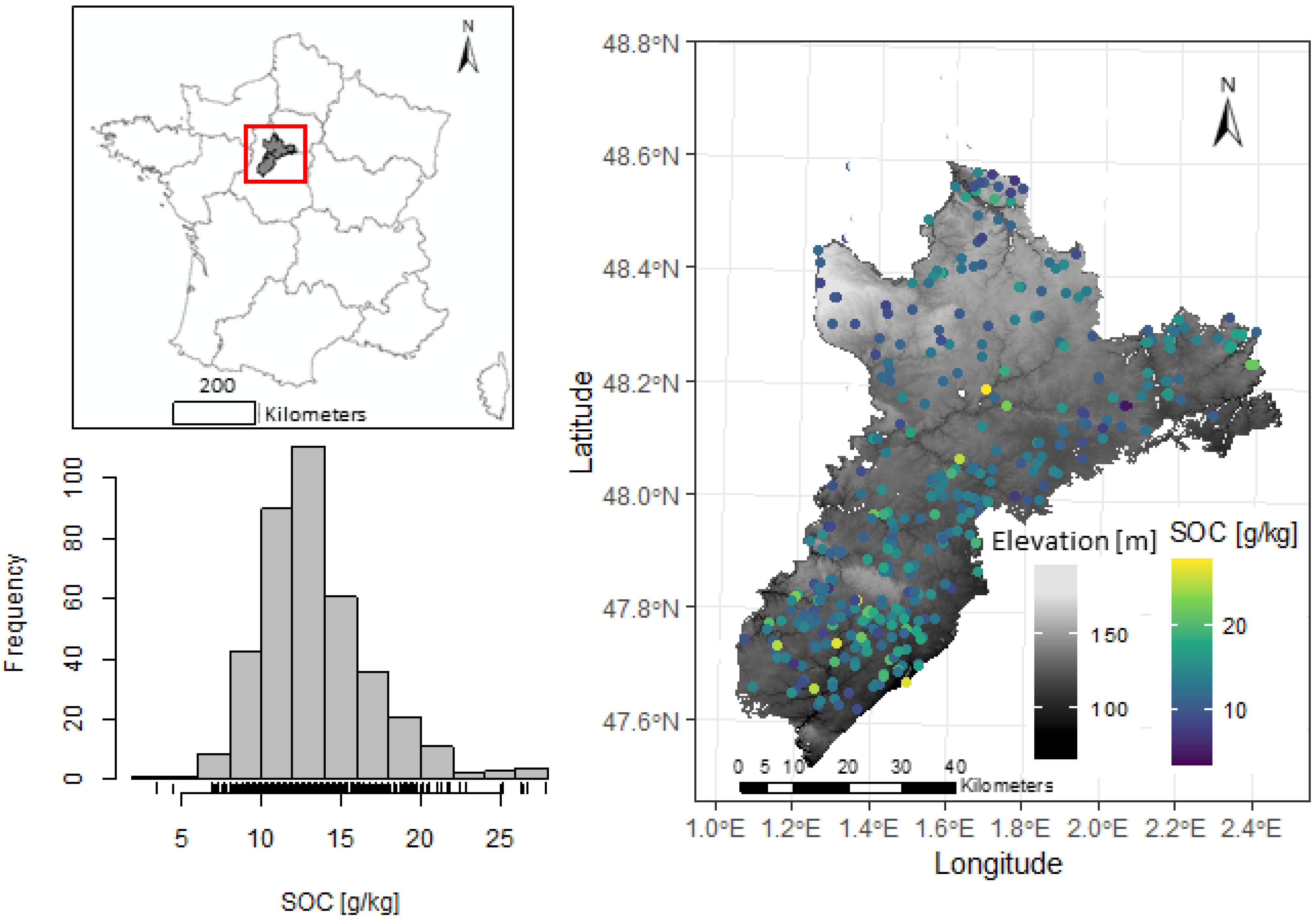
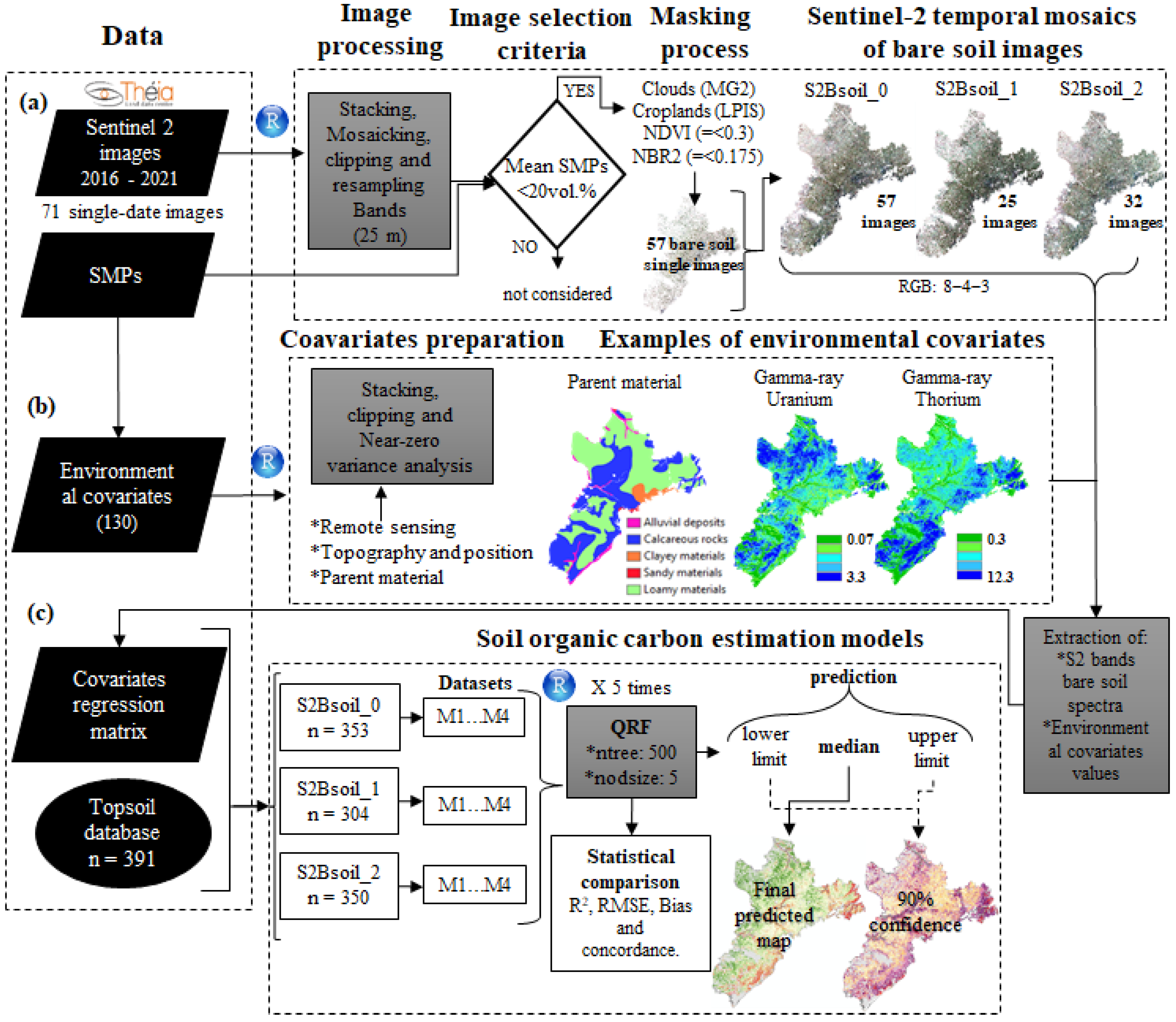
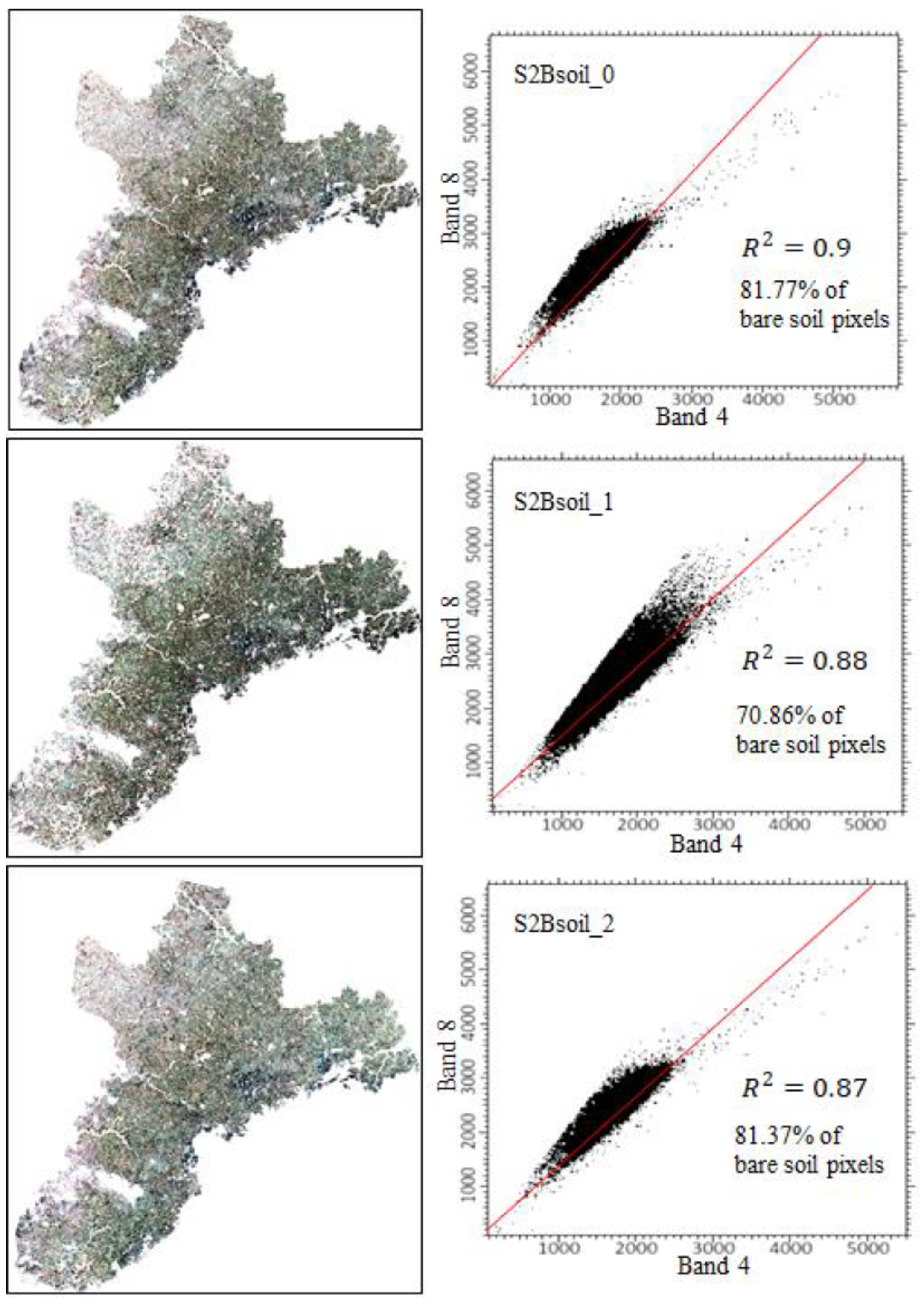
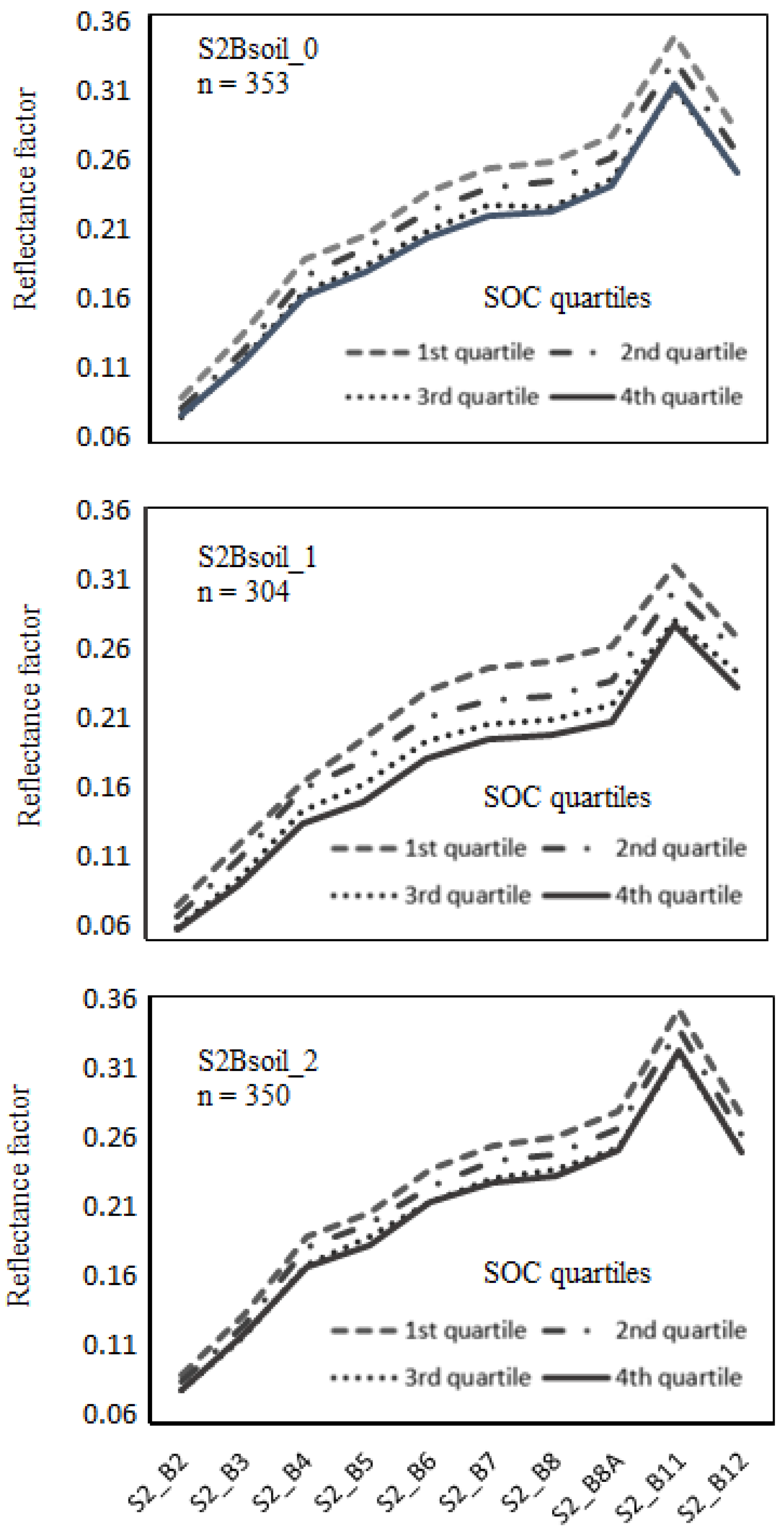
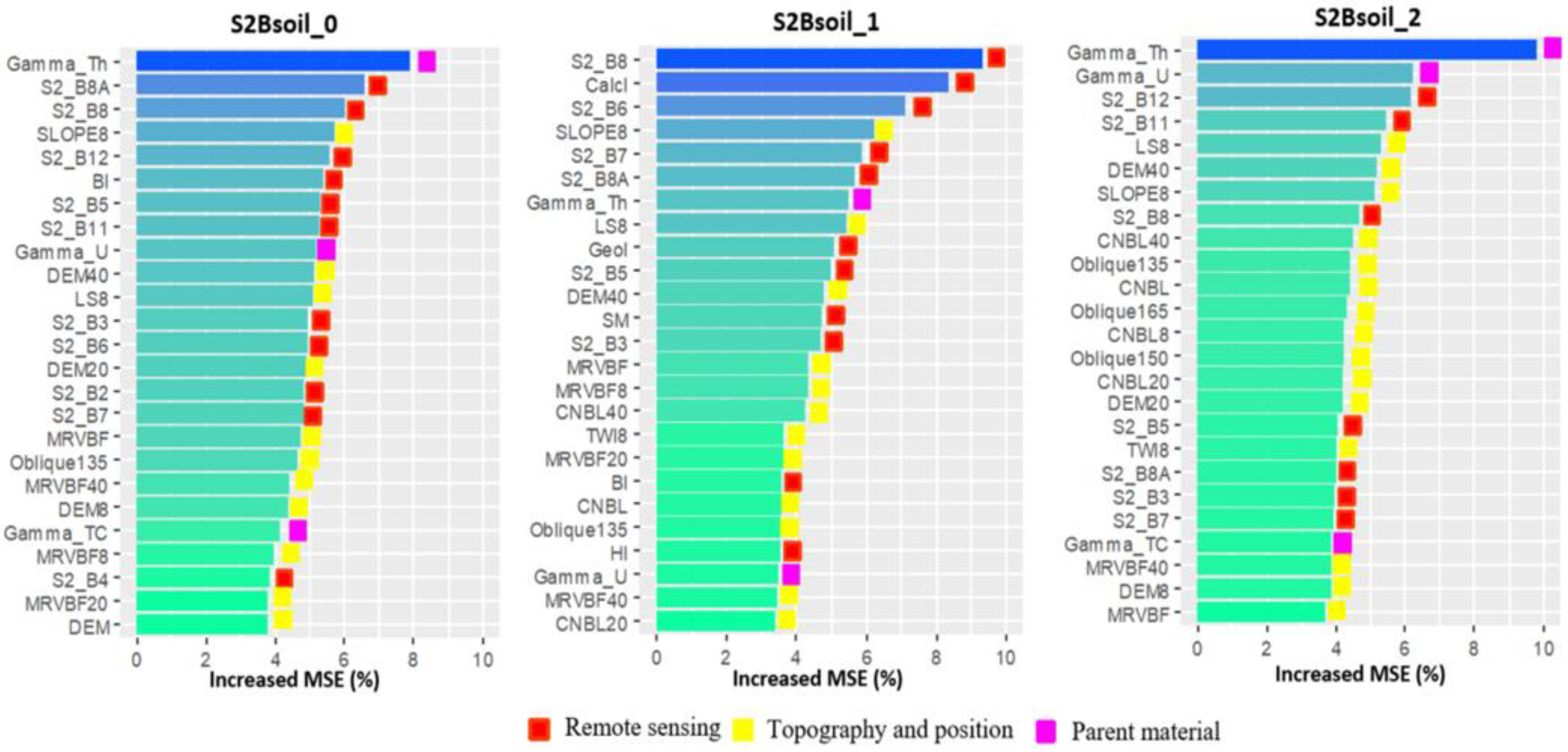
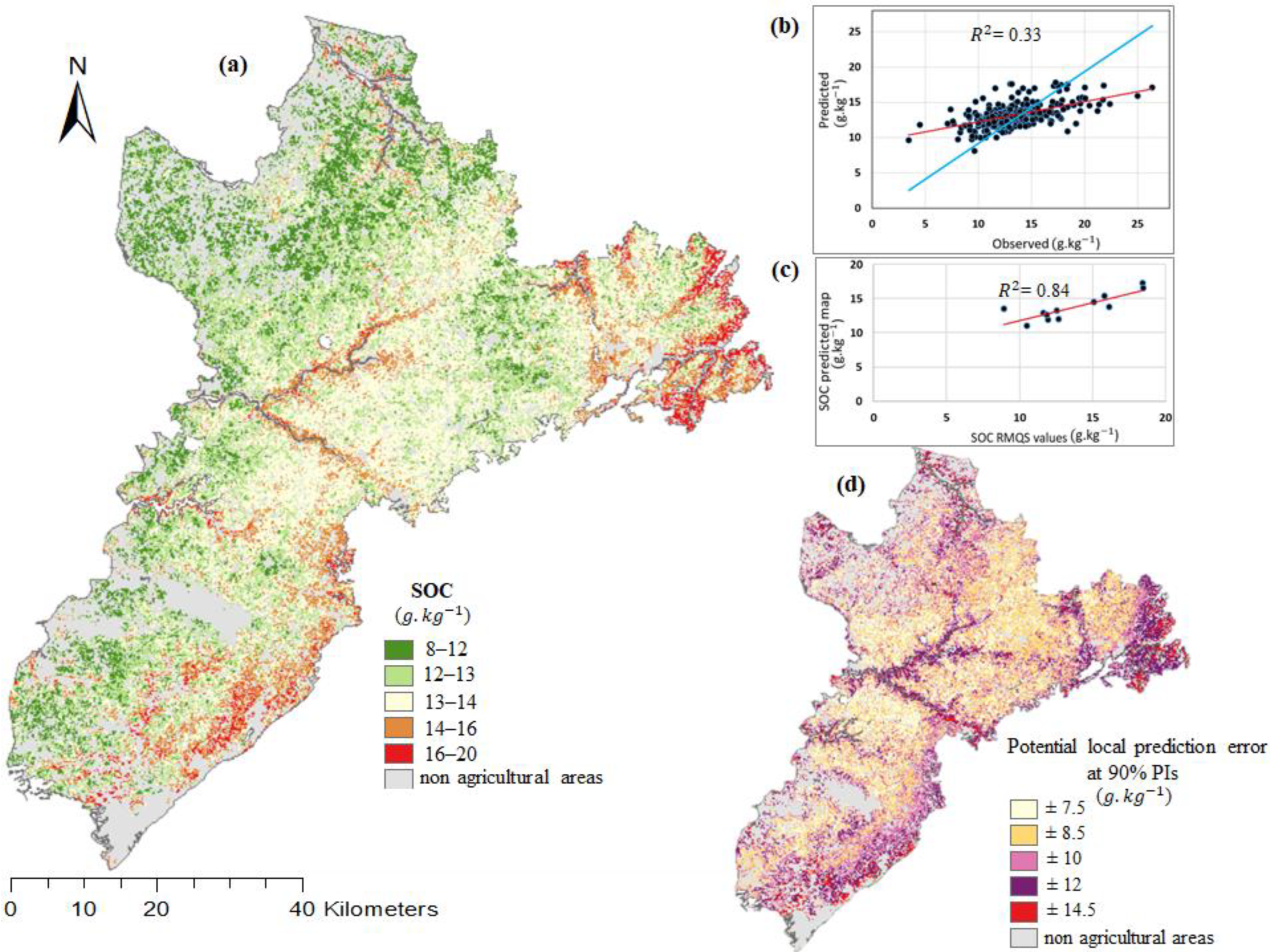
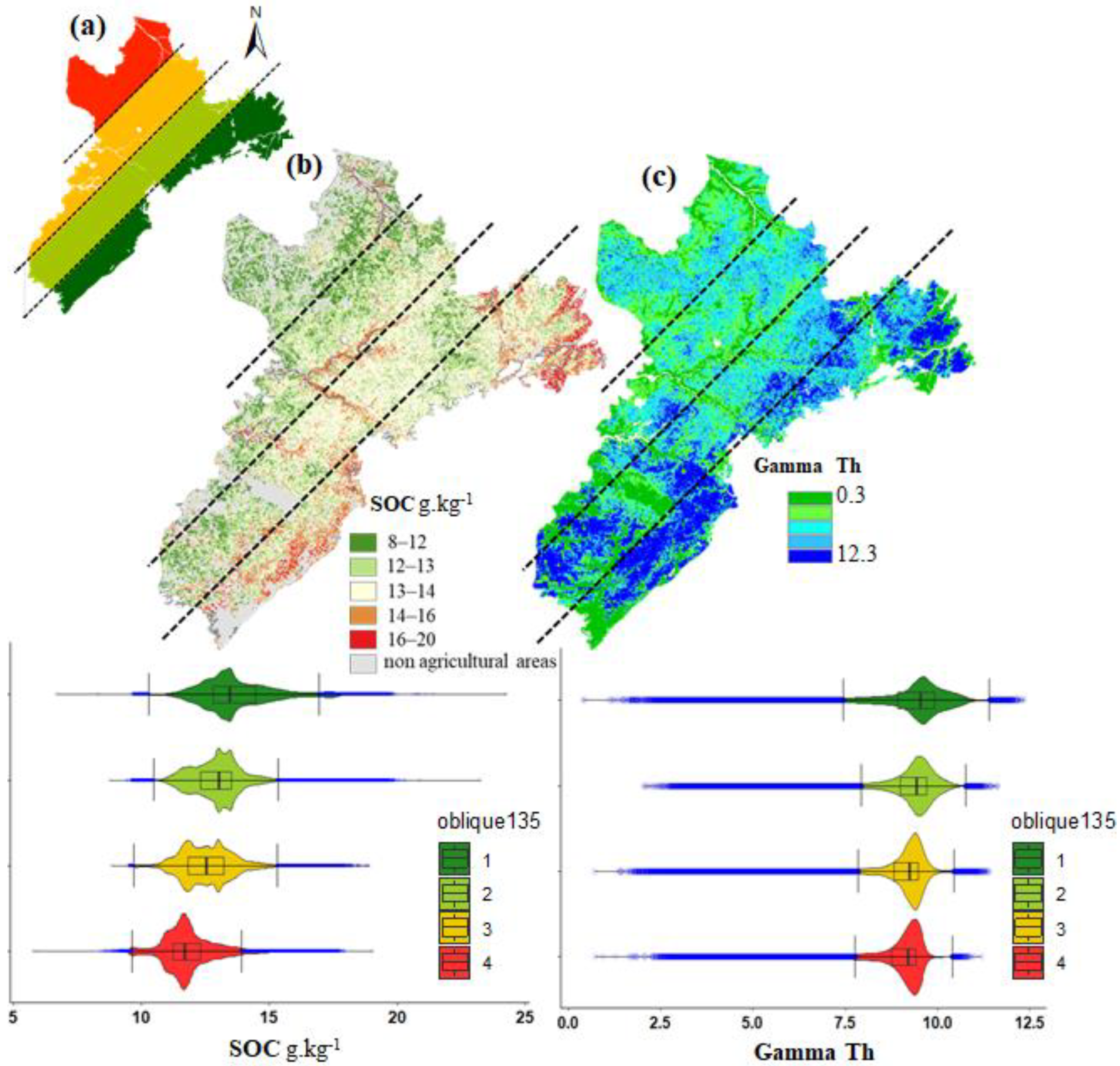
| Variable | Number | Scale/ Resolution | Expression a | Reference |
|---|---|---|---|---|
| Remote sensing | ||||
| S2Bsoil_0 b | 10 | 25 m | This study | |
| S2Bsoil_1 b | 10 | 25 m | This study | |
| S2Bsoil_2 b | 10 | 25 m | This study | |
| SM_0 c | 1 | 25 m | This study | |
| SM_1 c | 1 | 25 m | This study | |
| SM_2 c | 1 | 25 m | This study | |
| Hue Index (HI) | 3 | 25 m | (2 × R − G − B)/(G − B) | Mathieu et al. [47] |
| Grain Size Index (GSI) | 3 | 25 m | (R − B)/(R + G+B) | Xiao et al. [48] |
| Calcareous Sedimentary rocks (CalcI) | 3 | 25 m | (SWIR 1 − G)/(SWIR 1 + G) | Boettinger et al. [49] |
| Saturation Index (SI) | 3 | 25 m | (R − B)/(R + B) | Mathieu et al. [47] |
| Brightness Index (BI) | 3 | 25 m | (R² + G² + B²)/3) | Escadafal. [50] |
| Coloration Index (CI) | 3 | 25 m | (R − G)/(R + G) | Pouget et al. [51] |
| Carbonate Index (CaI) | 3 | 25 m | R/G | Boettinger et al. [49] |
| Geological response (Geol) | 3 | 25 m | (SWIR 1 − SWIR 2)/(SWIR 1 + SWIR 2) | Nield et al. [52] |
| First three PCs of NDVI S2Bsoil d | 9 | 25 m | This study | |
| First three PCs of monthly MODIS NDVI d | 3 | 500,300 m | Loiseau et al. [25] | |
| Topography and position | ||||
| Elevation | 4 | 25 m | IGN [53]; Chen et al. [54] | |
| Slope | 4 | 25 m | IGN [53]; Chen et al. [54] | |
| Slope position (PS) | 4 | 25 m | IGN [53]; Chen et al. [54] | |
| Slope length (LS) | 4 | 25 m | IGN [53]; Chen et al. [54] | |
| Terrain wetness index (TWI) | 4 | 25 m | IGN [53]; Chen et al. [54] | |
| Valley depth (VD) | 4 | 25 m | IGN [53]; Chen et al. [54] | |
| Vertical distance to channel network (VDCN) | 4 | 25 m | IGN [53]; Chen et al. [54] | |
| Multiresolution index of valley bottom flatness (MrVBF) | 4 | 25 m | IGN [53]; Chen et al. [54] | |
| Channel network base level (CNBL) | 4 | 25 m | IGN [53]; Chen et al. [54] | |
| Plan curvature | 4 | 25 m | IGN [53]; Chen et al. [54] | |
| Profile curvature | 4 | 25 m | IGN [53]; Chen et al. [54] | |
| Coordinates (Latitude, Longitude) | 2 | 25 m | ||
| Oblique coordinates (OC) e | 10 | 25 m | Chen et al. [54]; Møller et al. [55] | |
| Parent material | ||||
| Parent material | 1 | 1:1 M | King et al. [56] | |
| Gamma ray (K, U, Th, TC) | 4 | 250 m | Martelet et al. [37] |
| SOC g.kg−1 | ||||||||||
|---|---|---|---|---|---|---|---|---|---|---|
| S2Bsoil | Sites | Minimum | Q1 | Median | Mean | Q3 | Maximum | SD | Skewness | Kurtosis |
| S2Bsoil_0 | 353 | 3.46 | 11.40 | 13 | 13.4 | 15 | 27.8 | 3.34 | 0.86 | 4.83 |
| S2Bsoil_1 | 304 | 3.46 | 11.41 | 13 | 13.4 | 15 | 27.8 | 3.32 | 0.93 | 5.18 |
| S2Bsoil_2 | 350 | 3.46 | 11.39 | 13 | 13.4 | 15 | 27.8 | 3.35 | 0.85 | 4.82 |
| S2Bsoil | Modeling Dataset | R2 | RMSE (g.kg−1) | Bias | Concordance |
|---|---|---|---|---|---|
| S2Bsoil_0 | M1 | 0.18 | 3.00 | −0.33 | 0.32 |
| M2 | 0.19 | 2.98 | −0.31 | 0.33 | |
| M3 | 0.15 | 2.98 | −0.30 | 0.29 | |
| M4 | 0.26 | 2.75 | −0.20 | 0.40 | |
| S2Bsoil_1 | M1 | 0.19 | 2.97 | −0.32 | 0.35 |
| M2 | 0.22 | 2.90 | −0.30 | 0.35 | |
| M3 | 0.22 | 2.79 | −0.28 | 0.34 | |
| M4 | 0.33 | 2.59 | −0.22 | 0.42 | |
| S2Bsoil_2 | M1 | 0.11 | 3.17 | −0.35 | 0.25 |
| M2 | 0.11 | 3.14 | −0.30 | 0.24 | |
| M3 | 0.12 | 3.00 | −0.29 | 0.25 | |
| M4 | 0.27 | 2.71 | −0.21 | 0.39 |
Disclaimer/Publisher’s Note: The statements, opinions and data contained in all publications are solely those of the individual author(s) and contributor(s) and not of MDPI and/or the editor(s). MDPI and/or the editor(s) disclaim responsibility for any injury to people or property resulting from any ideas, methods, instructions or products referred to in the content. |
© 2023 by the authors. Licensee MDPI, Basel, Switzerland. This article is an open access article distributed under the terms and conditions of the Creative Commons Attribution (CC BY) license (https://creativecommons.org/licenses/by/4.0/).
Share and Cite
Urbina-Salazar, D.; Vaudour, E.; Richer-de-Forges, A.C.; Chen, S.; Martelet, G.; Baghdadi, N.; Arrouays, D. Sentinel-2 and Sentinel-1 Bare Soil Temporal Mosaics of 6-Year Periods for Soil Organic Carbon Content Mapping in Central France. Remote Sens. 2023, 15, 2410. https://doi.org/10.3390/rs15092410
Urbina-Salazar D, Vaudour E, Richer-de-Forges AC, Chen S, Martelet G, Baghdadi N, Arrouays D. Sentinel-2 and Sentinel-1 Bare Soil Temporal Mosaics of 6-Year Periods for Soil Organic Carbon Content Mapping in Central France. Remote Sensing. 2023; 15(9):2410. https://doi.org/10.3390/rs15092410
Chicago/Turabian StyleUrbina-Salazar, Diego, Emmanuelle Vaudour, Anne C. Richer-de-Forges, Songchao Chen, Guillaume Martelet, Nicolas Baghdadi, and Dominique Arrouays. 2023. "Sentinel-2 and Sentinel-1 Bare Soil Temporal Mosaics of 6-Year Periods for Soil Organic Carbon Content Mapping in Central France" Remote Sensing 15, no. 9: 2410. https://doi.org/10.3390/rs15092410
APA StyleUrbina-Salazar, D., Vaudour, E., Richer-de-Forges, A. C., Chen, S., Martelet, G., Baghdadi, N., & Arrouays, D. (2023). Sentinel-2 and Sentinel-1 Bare Soil Temporal Mosaics of 6-Year Periods for Soil Organic Carbon Content Mapping in Central France. Remote Sensing, 15(9), 2410. https://doi.org/10.3390/rs15092410










